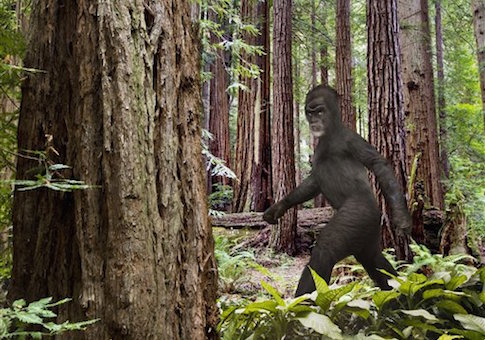The National Park Service is spending $149,927 researching Bigfoot, sea monsters, unexplained lights, and other paranormal activity.
Kawerak Inc., a nonprofit group that serves people of Eskimo, Aleut, or American-Indian descent in the Bering Strait region between Alaska and Russia, received the grant last year. The organization illustrates its project with a picture of "Hairy Man," a mythical Bigfoot-like creature.
The group is not just interested in researching "Hairy Man," but a whole host of "supernatural" creatures.
"Kawerak's Social Science Program has recently initiated a new research project on the 'Supernatural Environment,'" Kawerak's description of the project reads. "Phenomena that can be described as 'supernatural' include, among others, things such as sea monsters, little people, wild babies, unexplained lights, animals that can change into other things, and invisible sea birds."
The organization says the research is important to understanding how culture influences beliefs in the paranormal.
"The objective of the project is to document, in a serious and meaningful way, Bering Strait residents' knowledge about, experiences with, and beliefs about supernatural phenomena," the group said. "We think that this information is important to understanding how people relate to their environment and that there are culturally specific understandings of these phenomena which have not been previously documented."
The National Park Services originally announced its intention to award a $150,000 grant outside the normal competitive process to Kawerak for the supernatural study in March 2016.
The grant announcement said the study would also include "animals with transformative powers, a variety of other non-human persons, landscape features with special powers, and other similar phenomena."
Kawerak would "document as fully as possible from archival and other sources what is known about traditional beliefs, knowledge, and experience regarding the supernatural." The research also includes focus groups with community members about their "personal experience with the supernatural."
The group was given $50,000 for the project in June 2016.
A spokesperson for the National Park Service said the grant is part of the Shared Beringian Heritage Program, which dates back to the George H. W. Bush presidency, and receives $650,000 each year.
"The grant serves the program's broader goals of fostering a climate of mutual understanding as well as natural resource and cultural connections between indigenous people of northwest Alaska and northeast Russia," said John Quinley, a park service spokesperson. "Congress directs about $650,000 annually to the National Park Service for the program. That budget supports ongoing natural and cultural resource research conducted by a diverse group of partners including non-governmental organizations, academic institutions, tribal governments, and indigenous groups from the region."
"This grant to Kawerak, Inc. a non-profit organization serving the interests of Alaska natives, was supported through resolutions from 17 federally recognized tribes as this project documents the validity and importance of local and traditional knowledge held by tribal members," he said. "Individual project proposals are also vetted by a panel in Alaska prior to award by the NPS."
A progress report on the project from October shows a presentation at Tartu University, and a workshop where the stories of four tribal elders were told. The researchers are working on transcribing of the audio recordings of interviews.
Ultimately, the project will receive $149,927 by the time work completes in April 2019.
Julie Raymond-Yakoubian, the head researcher on the study, said the project is "proceeding well and is still ongoing."
Kawerak held a community meeting for the project in October on the supernatural environment, handing out door prizes to draw interest.
The organization received $22.4 million from the federal government in fiscal year 2016, with the majority of funds going towards Tribal self-governance, Head Start, and renewable energy programs.
Alaskan folklore includes stories of strange creatures, like the enukins, or "Little People," the "smallish, mischievous creatures of the night."
The television series Alaska Monsters, which stars a group of outdoorsmen led by "Little Bear," "Crusty," the researcher, and "Face," the expert tracker, documents various Bigfoot monsters roaming around the Alaska Triangle.
Episodes have featured video footage of "a Bigfoot," and a similar monster, "Bush Man."
"This sucker was big. It was intimidating. Scary. Not a creature that I want to meet in an alley somewhere," says Face, describing the Bush Man after seeing a blurry cell-phone video of the 10-foot-tall hairy beast.
Tales of sea monsters have haunted Alaska as well, and have even been promoted by the government. The Bureau of Land Management posted a mysterious video last fall of what appeared to be a monster lurking in the Chena River, leading many to speculate Alaska had its own ice version of "Nessie."
The monster turned out to be "an ice-covered rope caught on a pier."
Update 9 A.M.: This post has been updated to reflect comment from the National Park Service.
